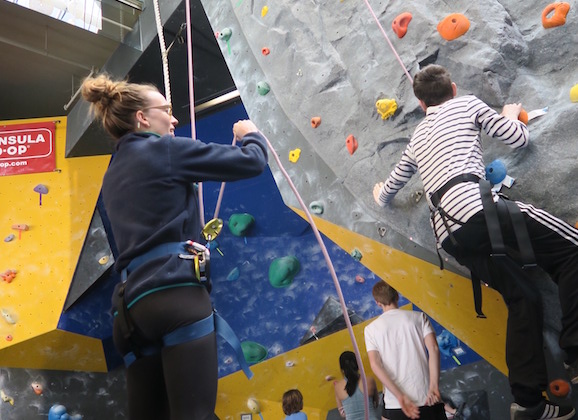Personalized Learning: The Future of Education?
Context
 I recently had the privilege of spending a semester as a teaching assistant in a first-year biology lab. It allowed me the opportunity to reflect on my own educational experience, while glimpsing back into the perspective of a first-year student.
I recently had the privilege of spending a semester as a teaching assistant in a first-year biology lab. It allowed me the opportunity to reflect on my own educational experience, while glimpsing back into the perspective of a first-year student.
It was a mixed bag of excitement, hope, failures, successes, redemption, and resilience. I found myself ruminating on the ideal that every student had the potential and capacity to pass every class. There are many personal, social, and circumstantial factors that contribute to a success or failure, but I decided to brainstorm some institutional barriers that may have the potential for change.
This is an opinion piece, a contrast to my journey deeply rooted in science and evidence-based education. My ponderings are completely speculative, but are a reflection of my own holistic experience with post-secondary education. It is important to give a short, superficial context of that experience. I have had a semester where I have failed most classes, and I have had a semester where I’ve achieved the highest possible grade in all classes.
I am now completing the co-op portion of my degree, and just recently interviewed to be a prospective student at medical school. If I could sum up my experience right now it is like teetering between success and failure, a sort of purgatory if I could say that without offending.
I like to think this gives me a unique perspective, but it is entirely possible I am just the first of the “snowflake” generation. As ill-informed, assumption laden, and self-indulgent as this may be, it is written with the underlying hope of benefiting future students who may be able to learn from the struggles I’ve faced.
The First Semester of University
The success of completing high school soon dissipates as those summer days get shorter and the prospect of university looms. Adulthood, independence, and opportunity dance in your thoughts as you are greeted by a culture of optimism.
Success and only success is on your mind, where in reality many students struggle to adapt to university. I did. So consumed in my own failure, it was difficult to comprehend the logistics and long-term ramifications of my educational career.
I simply could have dropped classes and avoided failure, yet I held out hope that I could turn it around when I clearly could not. The result was a semester of Fs, which would later bring down my academic average and threaten my academic suitability for medical school.
When I analyze this now, there are many personal circumstances that contributed to it, and I take full responsibility for my own shortcomings. I did not create a supportive environment, and I did not reach out for the mentorship I desperately needed. Now, as an instructor I could see some of these feelings emulated in the students I had the pleasure of teaching.
We need to decrease the failure rate of first year students. The variability in aptitude may be the greatest in first year. Many factors contribute: the values and beliefs of the student’s support system, the quality of secondary school education, and the financial support available.
A concerted effort must be made to better serve this transition into university. Instead of propagating a culture of optimism, students should have a mandatory briefing on many of the pitfalls of university such as when to drop a course to avoid the penalty of failure. Instructors and administrators should focus on trying to bring everyone up to the same level during this transition period.
First year courses could be structured with a back-loaded distribution of marks. First midterms and assignments should be an opportunity for adjustment and feedback, with little to do with a final grade. I find it hard to believe that the logistical annoyance of dealing with marking in a large class size outweighs the benefits of giving first-year students ample time to adjust to university.
As technology permeates society, attention spans shorten and therefore the effectiveness of a lecture-styled education are diminished. An attempt to understand and accommodate different learning styles into the delivery of content is crucial to the success of many future students. Could you imagine being assigned viewing of YouTube videos instead of textbooks?
As much as we romanticize and revere the great scientists and educators that came before us, and the delivery of content we are accustomed to, society has evolved. Children are brought up on different vessels of media today; therefore, it should be up to the student to choose the style and delivery of their education.
A Paternalistic Hierarchy to Student-Centered Education
In the progressive society we live in today, power is and will inevitably shift towards the student. Intimidation by academic hierarchies will cease to exist, and freedom of expression, creativity, and ideas will flow circularly. Financial, social, and intellectual barriers will disappear, and an altruistic utopian metropolis will emerge.
This obvious hyperbole may not be realistic, but institutions should strive as should individuals to be paragons to society. We should strive to achieve the values of inclusivity, integrity, respect, and diversity no matter how incrementally small the changes are. Fundamental to the concept of university will be the mindset that every person has the potential to be great given the right environment.
The Categorical System
Ideally, there would be a database of analytics that categorizes learning skills and outcomes for all students. This idea is too broad and complex in nature, so it may be easier to think of this in the context of one midterm.
For example, a midterm may test factual knowledge, ask for the integration of concepts, or application of knowledge to a novel situation. If you simply categorized the questions to produce a score in each of these areas, a student could then see that they were weak in a certain area. This knowledge could then allow them to modify their study habits. Next midterm, if they improve in that area, it would mean positive reinforcement and a solidification of that behaviour.
Equitable Distribution of Resources
The delivery of content would be diversified to reflect the needs of the student. Audio, video, kinesthetic, or a read/write delivery of content would be available. The goal would be to find what works optimally for a particular student. Learning style assessments would be constantly reviewed as the student embarks on their university education.
A plan needs to be implemented to ensure distributive justice. A system would be designed with equitable access and resources for every student. Currently, resources are set up in a way that many students only access them when critical levels of need and stress have already manifested. A system allowing issues to be flagged pre-emptively before critical levels are reached would be more beneficial for a student and potentially more efficient for an institution.
A personalized team of “mentors” would be assigned to every student upon their desire to attend university. One voice would be presented to a student, but multiple inputs would harmonize the voice. Student-athletes have coaches, trainers, therapists, and other supporting members of a team. Why can we not afford the same support to academic students?
The Manager – Assigned to the student before university begins and stays with student through their whole education. This is someone the student communicates directly with and synthesizes the information given by all analysts to inform the student – not persuade them.
Observational Analyst – Gives recommendations based on the observation of classroom learning, studying techniques, and interactions with others. Testing may include ability to understand another’s perspective, demonstrating the ability to understand both sides of an issue and have a thoughtful conversation about it, or the justification of thought processes. Quality feedback would be given, categorized based on skill being tested, which would give students better insight into their strengths and weaknesses.
Statistical Analyst – Displays statistical analysis of test scores, presentations, assignments, etc. Grading material would be broken down on what was being tested. For example, testing may test factual knowledge, integration of concepts, or the ability to quickly synthesize information to solve a problem. The delivery of feedback would be based purely on statistics.
Empowerment of student’s own voice – A student would be able to submit their own feedback to the team. A consideration of social, academic, and lifestyle factors would go into the analysis. The main goal would be to come up with a plan that considers all members of the team’s point of view and is mutually agreed upon by the manager and student.
Challenges We Face
Education is a pillar of society. It should be accessible to everyone regardless of age, gender, race, culture, religion, sexual orientation, and financial situation. Classrooms should be mosaics that represent the demographics of the population of a region.
The ability to draw from many different perspectives of life and learning would be invaluable. Seeing the world through different points of view promotes empathy and develops a culture of support and understanding. A team rather than individualistic culture would shift university to value not only talent, but the personal betterment of oneself.
Unfortunately, universities market mainly (if not exclusively) to high school students. The culture of competition puts off many people who have a desire to learn, and the competition, pressure, and stress put on students is increasing. Evaluation methods now involve percentage-based grading and the comparison to an average of all students in a class.
While this may provide evaluators of a transcript with the perception of more objective statistics, there are still way too many variables that contribute to a certain grade or class average that cannot be accounted for. Inevitably, everyone who scores below the class average is going to feel poorly about their grade. At the finish of a course, when you should be celebrating successful completion with your peers, many students are left feeling inadequate.
Increased housing prices and inflation along with the stagnation of wages are huge challenges anybody faces in today’s society. Education is a way that we can fight together against these problems; however, a culture that promotes competition and elitism has detrimental effects on the people in it currently and on how people view education.
Simple changes such as changing language such as “failed” in the vernacular could easily be implemented. Canadians view healthcare as a basic human right, and so should education be considered as such. We all have an obligation to progress the culture and promote creativity, communication, collaboration, diversity, and empathy. There is a place for everyone at university.
Conclusion
It is easy to get on a soapbox and preach about how things ought to be. In reality, time and resources are finite quantities thus limiting the application of grand ideas.
We all enter our respective industries as champions of change wanting to leave a lasting imprint for the better. We quickly realize that many barriers are in place for reasons that are insurmountable. Therefore, change cannot be one ideal or one person. To facilitate change requires the spreading of an idea like a seed that must be nurtured to grow.
Resistance will be faced, and only with the correct nutrients and environment does it sprout. It is the same for every student or every person for that matter. I truly believe there is greatness in all of us; we just have to nurture it.






